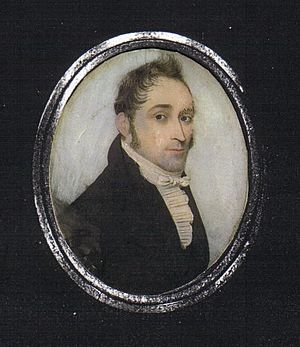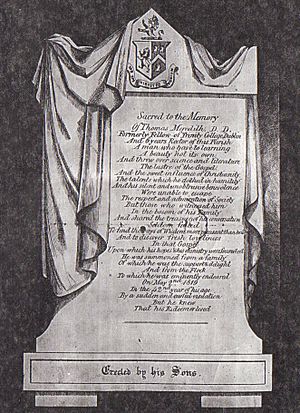Thomas Meredith facts for kids
Thomas Meredith (1777–1819) was an Anglo-Irish clergyman and a very smart mathematician. He was a Fellow at Trinity College, Dublin, which means he was a senior member of the university. He is best known for being friends with the poet Charles Wolfe. People also remember him because of a famous ghost story about him.
Contents
Early Life and Family
Thomas Meredith was born in 1777 at Templerany House in County Wicklow, Ireland. He was the oldest son of Ralph Meredith, who was a lawyer and a local judge. His mother was Martha Chaytor, whose family owned a lot of land in County Clare.
Thomas's father chose to work as a lawyer in Dublin. So, he let his younger brother, William, manage their family home at Templerany. The Meredith family had lived there since the late 1600s.
Education and Career
Thomas Meredith grew up in Dublin on Harcourt Street. A relative named Samuel Crumpe taught him at home. In 1791, when he was 14, Thomas started studying at Trinity College, Dublin. He was a "pensioner," which meant his family paid for his studies.
Just two years later, in 1793, he became a "scholar" at the college. This meant he was a top student and received financial help. He earned his first degree in 1795.
After college, Thomas spent a few years looking after his family's land in different counties. But he also spent his free time working on new ideas in mathematics.
In 1805, he earned his Master's degree. In the same year, he became a Fellow of Trinity College. People remembered him as a brilliant mathematician. One person said he was "the best lecturer and tutor of his time in college." He had a large collection of books and maps at his home in Dublin.
A story from 1842 tells how amazed Thomas Meredith was by a very young boy named William Rowan Hamilton. This boy, only six or seven years old, could read and understand Hebrew better than many older students trying to become Fellows!
In 1811, Thomas earned a Bachelor of Divinity degree, and the next year, he became a Doctor of Divinity. In 1813, he left his position at Trinity College to become the rector (a type of priest) of Ardtrea in County Tyrone. This job was only for former Fellows of Trinity College.
The Ardtrea job was very good, bringing in a lot of money each year. The rector also managed the Ardtrea area. Thomas and his family lived in Ardtrea House, a large and beautiful stone house. People in Ardtrea remembered Thomas Meredith for always helping those in need and never turning anyone away from his door.
He was the rector of Ardtrea for six years. Sadly, he died suddenly in 1819 when he was only 42 years old. His father-in-law said it was a "sudden and awful visitation." The Freeman's Journal newspaper in Dublin reported that he was "respected and sincerely beloved" and that his death was a "premature departure." He left behind his wife and seven young children.
Friendship with Charles Wolfe
The famous poet Charles Wolfe was a very close friend and admirer of Thomas Meredith. Wolfe was a curate (a junior priest) in a nearby town and often visited the Meredith family at Ardtrea House.
Charles Wolfe is best known for his poem The Burial of Sir John Moore after Corunna. He also wrote the words for Thomas Meredith's memorial at the Church of Ardtrea. This memorial is made of black and white marble and shows the Meredith family's coat of arms.
Here is what Charles Wolfe wrote for Thomas Meredith's memorial:
Sacred to the memory of THOMAS MEREDITH D.D., Formerly Fellow of Trinity College Dublin, And 6 years Rector of this Parish. A man who gave to learning a beauty not its own, And threw over Science and Literature the lustre of the Gospel And the sweet influence of Christianity. The talents which he clothed in humility And his silent and unobtrusive benevolence Were unable to escape the respect and admiration of society: But those who witnessed him in the bosom of his family And shared the treasures of his conversation Seldom failed to find the ways of wisdom more pleasant than before And to discover fresh loveliness in that Gospel Upon which his hopes and his ministry were founded He was summoned from a family of which he was the support and delight And from the flock to which he was eminently endeared On 2nd May 1819 in the 42nd year of his age By a sudden and awful visitation but he knew That his Redeemer lived. ‘Erected by his Sons’.
Wolfe also wrote another poem for Meredith, which was meant for his tomb:
Here lies in this lone spot, this holy shade,
One less for earth than heavens high mansions made,
Whose virtues all in paths untrodden moved,
Too little known, alas! Too much beloved!
Whom talent, science, wisdom, goodness crowned,
With wreaths as gentle as these flowers around,
Whose modest beauty shun all common eyes,
To bless this sacred spot, these purer skies,
And like his bloom in home's sequestered Vale,
To him who gave them all their sweets exhale,
But us't to human praise he sought not such,
Unheeding all but his he loved so much,
Then be our task to fit our minds to raise
In purer Worlds a fitter song of praise,
For them alone to know his worth is given
Who lived on earth as Saints shall live in Heaven.
In 1817, Wolfe wrote a letter showing how much he valued Meredith's friendship. He said that at Meredith's home, he felt "every way at home" in friendship, learning, and talking about religion.
After Meredith's death, Wolfe wrote a letter in May 1819, expressing his deep sadness. He said, "Oh… one of my heart-strings is broken!" He described Meredith as a man with a truly Christian and humble spirit.
The Ghost Story
The memorial for Thomas Meredith mentions his "sudden and awful visitation" that led to his death. There are two interesting stories about him shooting at a ghost with a silver bullet.
One story appeared in a book called Memorials to the Dead in 1903. Later, in 1924, the rector of Ardtrea, Rev. Ernest Richard Scott, who was married to one of Thomas Meredith's great-granddaughters, wrote a letter about it. He said that the rectory house was old and mysterious.
The story goes that a governess (a teacher who lived with the family) working for Dr. Meredith was bothered by a ghost. The ghost looked like a lady in white. Some local people thought it might be Saint Trea, who lived there long ago. The ghost troubled Dr. Meredith so much that, following a friend's advice, he loaded a gun with a solid silver bullet. He waited for the ghost at midnight. A shot was heard, and the next day, the rector was found dying in a basement room. After this, local people avoided the "haunted" house.
Another version of the story appeared in True Irish Ghost Stories in 1926. This story says that the ghost haunted the rectory so much that Meredith's family and servants left the house. The rector tried to shoot the ghost but failed. Then he was told to use a silver bullet. He did, and the next morning, he was found dead at his front door. A horrible, devil-like creature made loud noises from the windows.
A servant was advised by neighbors to get a priest to "lay" (get rid of) the ghost. The priest arrived and, with the help of some whiskey, the ghost became friendly. But when the priest was about to drink the last bit of whiskey, the ghost turned thin and long like an eel and slipped into the jar to get the last drops. The priest quickly put the cork back in, hammered it tight, and made the sign of the Cross. He had trapped the evil thing! It was buried in the rectory cellar, and some nights, people say you can still hear it calling to be let out.
Family Life
On July 7, 1807, Thomas Meredith married Elizabeth Maria Graves in Dublin. She was the oldest daughter of Richard Graves, a theologian. Elizabeth was described as a "lady of much culture and refinement" and had a strong personality.
Thomas and Elizabeth had seven children:
- Mary Anne Meredith: She was beautiful and talented, a good actress and musician. She died young in Ireland.
- Rev. Richard Graves Meredith (1810–1871): He was very tall and studied at Trinity College, Dublin. He was a close friend of the poet Thomas Campbell.
- Chief Justice Sir William Collis Meredith: He became a judge.
- Harriet Meredith (1813–1906)
- Ralph Henry Howard Meredith (1815–1892): He moved to Port Hope, Ontario, Canada.
- Edmund Allen Meredith (1817–1899): He became the Principal of McGill University in Canada.
- Thomas L. Meredith (1819–1843): He died in Ireland.
After Thomas Meredith died, his wife Elizabeth and their children moved back to Harcourt Street in Dublin. In 1824, Elizabeth remarried her mother's cousin, Rev. James Edmund Burton. He had lost all his money in Ireland.
At the invitation of a religious group, James Burton went to Terrebonne, Quebec, Canada, to become the first Anglican minister there. He was also given a large amount of land. He later returned to Ireland to find a new wife for his ten children from his first marriage.
After marrying Elizabeth Meredith, he returned to Canada in the summer of 1824 with his new wife and four of her children. They lived on his farm, 'Burtonville,' near Rawdon, Quebec. It was a four-day journey north of Montreal at the time.
They lived there until 1833 before moving to Cloyne, County Cork, Ireland. Elizabeth left James Burton's children from his first marriage in Canada. However, Thomas Meredith's children were said to have taken a great interest in helping their younger half-brothers and sisters. Thomas Meredith's widow, Elizabeth, died in Edinburgh, Scotland, in 1855.
|



